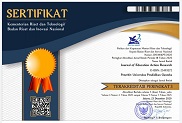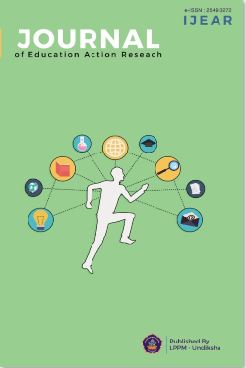Improving The Vocabulary Mastery Through Numbered Heads Together Technique of The Seventh Grade Students of SMP N 5 Baturiti In Academic Years 2015/2016
DOI:
https://doi.org/10.23887/jear.v1i1.10117Abstract
This study aim at: (1) to find out whether Numbered Heads Together can improve students’ vocabulary mastery, (2) to find out the response of the students toward the implementation of the strategies. There were two kinds of data (qualitative and quantitative data) which were collected through tests, questionnaire, and writer’s diary. The students’ mean score was 4.63% in pretest, 6.2 in posttest 1, and improved became 7.97 in posttest 2. There were no students passed in the pretest, 2 students in the posttest 1, and 18 students in the posttest 2. The result of writer’s diary and questionnaire also showed that the students gave positive response toward the strategies. The results of the questionnaires showed that 18 (90%) of the students admitted that they really like the implementation of Numbered Heads Together. Moreover, 17 (85%) of the students admitted that they were motivated in learning English using Numbered Heads Together.
References
Brown, H. Douglas. 2004. Language Assessment Principles and Classroom Practices. New York: Pearson Education.
Celce, Marianne and Murcia. 1991. Teaching English as a Second or Foreign Language. Boston: Heinle and Heinle Publishers.
Coady, James and Thomas Huckin. 1997. Second Language Vocabulary Acquisition. Cambridge: Cambridge University Press.
Daller, Helmut and James Milton, 2007.Modeling and Assessing Vocabulary Knowledge. Cambridge: Cambridge University Press.
Danil Baker. 2013. Effective of Numbered Heads Together Technique As Individual Instruction For All Groups Of Students. homepages.lboro.ac.uk. Retrieved 24 February 2015.
Darsana. 2014. Using Numbered Heads Together Technique To Improve Student In Vocabulary Mastery. a multidisciplinary journal, v46 n1 p1-29 mar 2014. Retrieved june 25, 2015, from, eric.ed.gov/id=EJ682769
Georgiou, Sophie Joannou andPavlospavlou. 2003. Assessing Young Learners. Oxford: Oxford University Press.
Hiebert, Elfrieda H. and Michael L. Kamil. 2005. Teaching and Learning Vocabulary: Bringing Research to Practice. London: Lawrence Erlbaum Associates, Inc
Maharani. 2013. The effectiveness of Using Numbered Heads Together To Improve Vocabulary Mastery of The Fifth Grade Students of SD N KARANGGEDE In The Academic Yeers 2012/2013. Purworejo: Muhamadiyah University of Purworejo:a multidisciplinary journal,v38 n1 p1-30 Jul 2013. Retrieved june 25, 2015, from, eric.ed.gov/id=EJ682769.
McCarten, Jeanne. 2007. Teaching Vocabulary: Lesson from the Corpus; Lessons for the classroom. Cambridge: Cambridge University Press
Prehanta. 2014. The effect Of Using NHT Technique On The Seventh Grade Students’ Vocabulary Achievement At SMP Negeri 2 Kalisat In The Academic Years 2013/2014. Jember: UniversitasJember.
Rahmawati. 2014. Cooperative learning type numbered heads together in improving reading comprehension of The Student at SMP N 20 Tanggerang. Journal of Behavioral Education;Sep2014, Vol. 18 Issue 3, p222
Takac, VisnjaPavicic. 2008. Vocabulary Learning Strategies and Foreign Language Acquisition. Bristol: Multilingual Matters Ltd.
Thornbury, Scott. 2002. How to teach Vocabulary. London: Pearson Education Limited.
Tileston, Donna Walker. 2004. What Every Teacher Should Know about Efective Teaching Strategies. Londom:Corwin Press.
Trianto. 2007. Model-Model PembelajaranInovatifBerorientasiKonstruktivistik. Jakarta: PrestasiPustaka.
Yukya. 2010. Numbereh Heads Together Technique To Improve Student’s Vocabulary Mastery In SMP N 1 Ubud. Ubud: Universitas Mahasaraswati.











